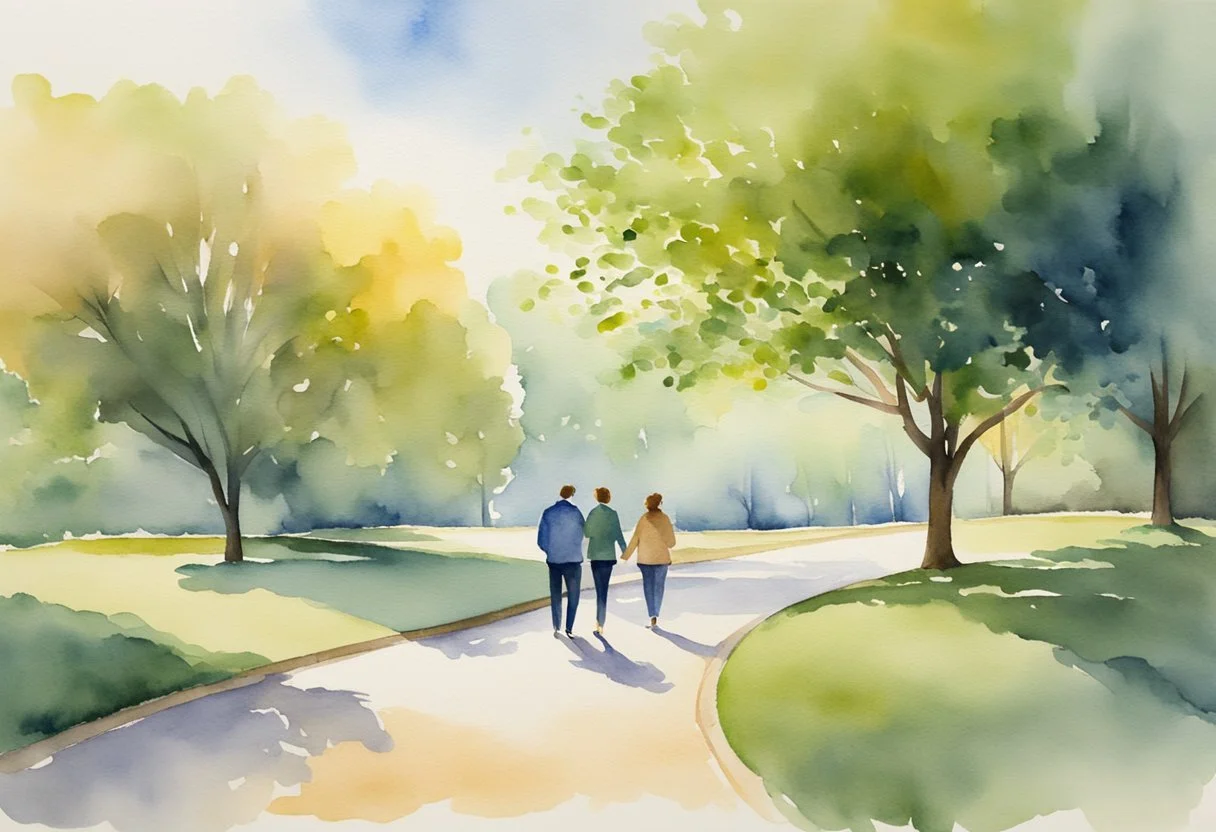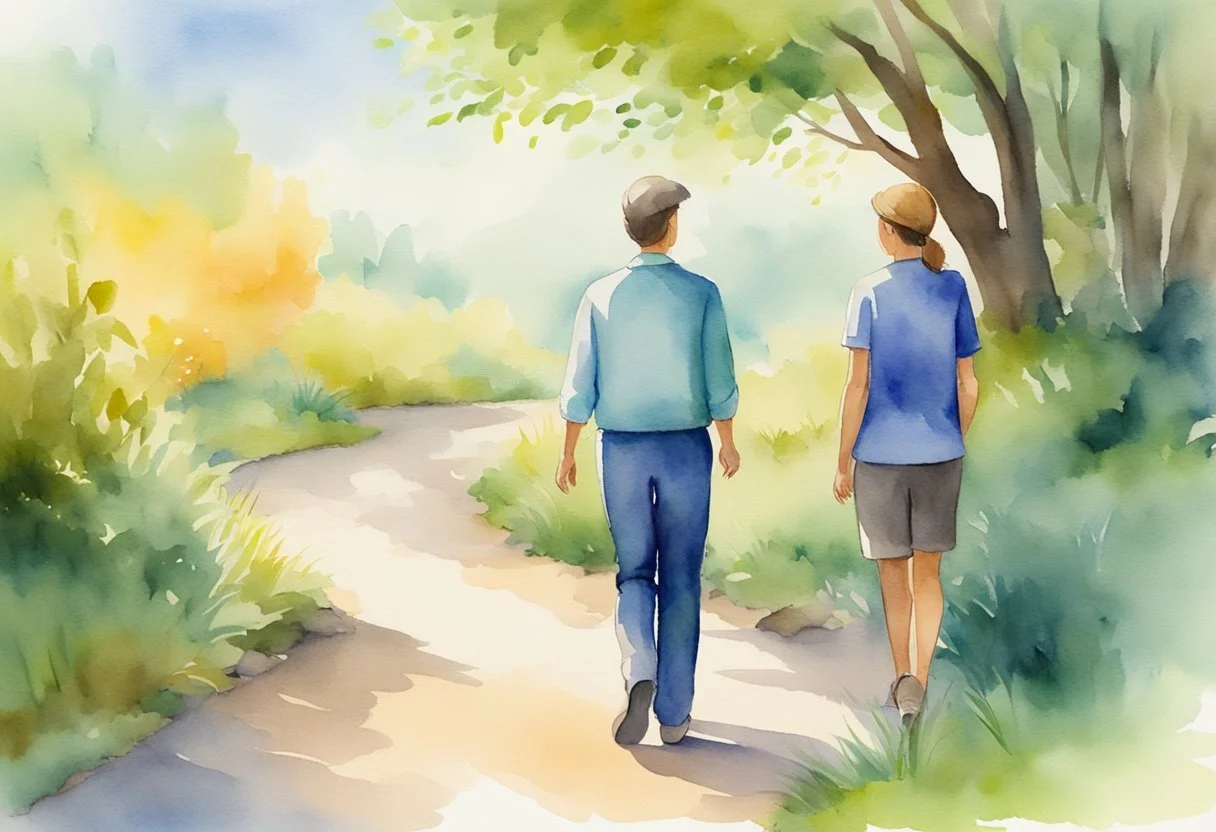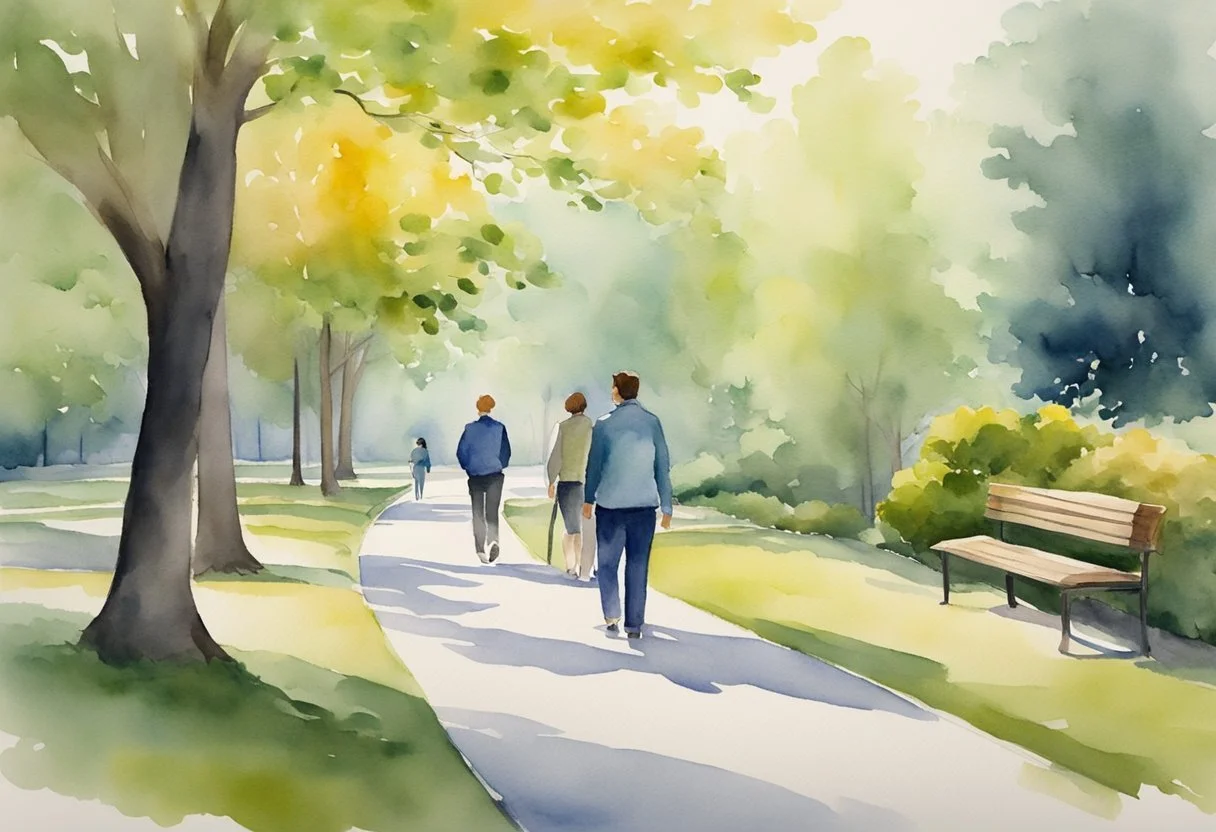What is Walk and Talk Therapy? A Concise Overview for Mental Wellness Seekers
Walk and talk therapy is a unique approach to traditional therapy that combines elements of both physical activity and psychological support.
This innovative method involves clients engaging in therapeutic conversations with mental health professionals, such as therapists or counselors, while walking together outdoors.
By taking advantage of the natural environment, walk and talk therapy can promote relaxation, a sense of well-being, and improved mental health.
One of the main reasons walk and talk therapy has gained popularity is the understanding of the positive impact of exercise on mental health. Physical activity is known to reduce symptoms of anxiety and depression and can enhance mood through the release of endorphins. In addition, regular walking provides a range of physical health benefits such as improved cardiovascular health and weight management.
Key Takeaways
Walk and talk therapy combines physical activity with psychological support, conducted outdoors with a mental health professional.
Exercise plays a vital role in improving mental health, reducing anxiety and depression symptoms, and enhancing mood.
The natural environment used in walk and talk therapy offers unique benefits for relaxation and overall well-being.
Understanding Walk and Talk Therapy
Basics of Walk and Talk Therapy
Walk and talk therapy is a type of eco-psychotherapy that combines mental health care with physical activity and spending time in nature. During these therapy sessions, you engage in conversation with your therapist while walking in a natural setting, such as a park or a local trail. This approach encourages movement and the benefits of being surrounded by nature, ensuring that you receive fresh air during your sessions.
Benefits of Movement and Nature
There are several advantages to incorporating movement and nature in your therapy sessions. Engaging in physical activity, such as walking or hiking, can release endorphins, which are the body's natural mood-enhancing chemicals. This release can help improve your mental well-being and make discussing emotions and issues with your therapist more manageable.
Additionally, being in nature can help reduce stress and anxiety by providing a calming environment where you can focus on your thoughts and feelings. Some of the key benefits of walk and talk therapy include:
Improved mental health: Spending time in nature has been linked to positive improvements in various mental health conditions, including anxiety, depression, and stress.
Enhanced problem-solving: Moving while talking can stimulate your brain, helping you think more clearly and creatively during therapy sessions.
Increased physical fitness: Regular physical activity during therapy can help improve your overall health and well-being.
Greater engagement: The outdoors and the act of walking can provide natural distractions, helping you feel more comfortable opening up to your therapist.
Overall, walk and talk therapy offers a unique, holistic approach to mental health care, combining the benefits of motion, nature, and traditional therapy into one effective treatment.
Therapeutic Process and Structure
Session Dynamics
In walk and talk therapy, you engage in a therapeutic conversation with your therapist while walking together outdoors. This unique approach combines the benefits of physical activity with the healing power of nature, creating a relaxing and invigorating environment for discussing your feelings, thoughts, and challenges. The therapist may guide you along a specific route during the session, or allow you to choose the path as the conversation unfolds. This flexible structure can help you feel more in control and promote self-exploration.
Walk and talk therapy is suitable for clients dealing with various mental health conditions, such as anxiety, depression, and stress. The combination of movement, fresh air, and the natural environment can enhance the therapeutic process by promoting relaxation and well-being. Additionally, the act of walking can help stimulate both your body and mind, facilitating more open and honest communication with your therapist.
Safety and Privacy Concerns
While walk and talk therapy offers numerous benefits, it is essential to address safety and privacy concerns during these sessions. Since you will be in a public setting, maintaining confidentiality can be challenging. However, your therapist will work with you to establish clear boundaries and guidelines to protect your privacy.
Your therapist may choose quieter, less crowded locations to minimize distractions and reduce the risk of others overhearing your conversation. Alternatively, you and your therapist can develop strategies such as speaking in a lower tone or pausing the discussion if others are nearby. It is crucial to discuss any concerns or preferences you have regarding privacy and confidentiality with your therapist to ensure a comfortable and secure experience.
Safety during walk and talk therapy sessions is another important aspect to consider. Your therapist should prioritize selecting a safe route and environment to conduct the session, taking into consideration factors like terrain, weather, and potential hazards. It is also essential for both you and your therapist to wear appropriate footwear and clothing, depending on the location and weather conditions. Moreover, make sure to communicate any physical limitations or concerns you may have with your therapist to ensure a safe and enjoyable experience.
In summary, walk and talk therapy provides a unique and effective approach to addressing mental health concerns, with the added benefits of physical activity and nature's healing power. By addressing session dynamics, safety, and privacy concerns, you and your therapist can work together to create a rewarding and tailored therapeutic experience.
Effects on Specific Mental Health Issues
Managing Stress, Anxiety, and Depression
Walk and talk therapy can be a helpful tool to manage common mental health issues such as stress, anxiety, and depression. By combining physical activity with therapy, you can reap the benefits of exercise while also engaging in a therapeutic conversation. Exercise is known to improve mental health by reducing symptoms of anxiety and depression through the release of endorphins, which enhance mood and mental alertness.
Some benefits of walk and talk therapy that could help manage these mental health issues include:
Reduced Stress: Walking in nature has a calming effect, which can lower your stress levels.
Improved Mood: Physical activity stimulates the release of endorphins, leading to a more positive outlook.
Mental Clarity: Engaging in a conversation while walking can help you focus and improve your problem-solving skills.
Impact on Other Emotional Challenges
In addition to managing stress, anxiety, and depression, walk and talk therapy can have positive effects on other emotional challenges like anger, loss, grief, and fear. By walking alongside a therapist, you can explore these emotions in a supportive and safe environment. The natural setting can promote relaxation and a sense of well-being, making it easier for you to process your feelings and find coping mechanisms.
Some of the key aspects of walk and talk therapy that can help you face other emotional challenges are:
Emotional Expression: The relaxed ambiance provided by walking outdoors allows you to open up more about your feelings.
Mindfulness: Walking in nature can foster a sense of mindfulness, helping you become more aware of your emotions and thoughts.
Coping Skills: A therapist can work with you to develop healthy coping mechanisms for dealing with difficult emotions.
In summary, walk and talk therapy can be a valuable tool to address various mental health concerns such as stress, anxiety, depression, anger, loss, grief, and fear. By taking advantage of the calming effects of nature and the benefits of physical activity, you can enhance your emotional well-being and find effective coping strategies for your emotional challenges.
Comparing Traditional and Outdoor Therapies
Walk and Talk vs. Traditional Therapy Settings
In traditional talk therapy, you typically find yourself seated in an indoor office setting, often facing your therapist while discussing your thoughts and feelings. However, outdoor therapy provides a different experience, taking you out of the enclosed therapy room and immersing you in a natural environment.
For instance, Walk and Talk therapy is an innovative form of outdoor therapy in which the therapeutic conversation takes place while walking together with your therapist. Imagine strolling through a beautiful public park in New York while discussing your emotions and experiences with a therapist by your side. This approach encourages mental well-being by combining the benefits of physical activity and exposure to nature.
Here is a brief comparison of Traditional Talk Therapy and Walk and Talk therapy:
Attribute Traditional Talk Therapy Walk and Talk Therapy Location Indoor office setting Outdoor public spaces Body Movement Generally sedentary Active, walking Exposure to Nature Minimal Significant Social Interaction Limited to therapist Exposure to public
There are several aspects where outdoor therapies might have an edge over their indoor counterparts. Being in nature can create a feeling of serenity and relaxation, reducing stress levels, and enhancing mood. Moreover, physical activity during walk and talk therapy, even as simple as walking, releases endorphins which improve mental alertness and emotional well-being.
It's important to consider your personal preferences and needs when deciding between traditional talk therapy and walk and talk therapy. Remember, both options aim to promote your mental well-being. The key is finding the therapeutic setting that feels most comfortable and effective for you.
Practical Considerations
Accessibility and Insurance
When considering walk and talk therapy, it's important to be aware of the accessibility and insurance implications. Walking therapy might not be an ideal option for everyone due to physical limitations or accessibility concerns. However, many therapists are willing to adjust and tailor their approach to suit your needs, ensuring both your comfort and wellbeing during the session.
Regarding insurance, the coverage for walk and talk therapy may vary depending on your policy and the mental health professional you choose. It's essential to consult with your insurance provider to determine if walk and talk therapy is covered under your plan. Also, some therapists may offer a sliding scale or payment plans to make sessions more affordable.
Choosing a Therapist and Location
As with any type of therapy, establishing a strong therapeutic relationship is crucial for the success of walk and talk therapy. To find a suitable mental health professional, you can use directories where therapists specializing in walk and talk therapy are listed. Be sure to research their credentials and experience before making a decision.
When choosing a location for your sessions, consider factors such as privacy, safety, and convenience. Your therapist should be able to suggest appropriate places where you can feel relaxed and comfortable while discussing your concerns. It's essential to maintain open communication and flexibility to adjust the location or format of the therapy if needed.
Incorporating mindfulness in walk and talk therapy can enhance your overall experience during the sessions. This approach encourages you to be present in the moment and observe your surroundings, which can be therapeutic in itself. Connecting with nature can also promote a sense of calmness and wellbeing.
To summarize, walk and talk therapy may offer unique benefits due to its combination of physical activity, connection with nature, and traditional therapeutic techniques. However, it's essential to weigh the practical considerations like accessibility, insurance, and finding a suitable therapist and location to ensure a positive experience during your therapy sessions.
Frequently Asked Questions
How is walk and talk therapy integrated into traditional therapy practices?
Walk and talk therapy is a form of eco-psychotherapy where therapy sessions are conducted outdoors and involve walking. It can be integrated into traditional psychotherapy by combining indoor sessions with outdoor walking sessions tailored to the client's preferences and needs. This approach offers the benefits of nature, movement, and conventional talk therapy.
Can walk and talk therapy be effective for all age groups?
Yes, walk and talk therapy can be effective for various age groups, as it can be adapted to suit clients' physical abilities and personal preferences. While some may prefer more strenuous activities, others may need gentler walks. Walk and talk therapy has been shown to help individuals with various mental health conditions, including anxiety, depression, and stress.
What are the ethical considerations involved in walk and talk therapy?
Some ethical considerations for walk and talk therapy include maintaining confidentiality, ensuring the client's safety during sessions, and addressing the therapeutic relationship. Therapists must be aware of their surroundings and choose locations that provide privacy and a comfortable environment for the therapy session. Additionally, therapists must take into account any physical limitations or health concerns of their clients.
How does walk and talk therapy compare to conventional talk therapy in terms of outcomes?
While both conventional talk therapy and walk and talk therapy aim to improve mental health, walk and talk therapy has additional benefits due to its outdoor setting and physical activity component. Research has shown that physical activity can improve mental health, reduce anxiety and depression symptoms, and enhance mood. However, each individual's experience and progress may vary, and it is essential to consider the client's unique needs and preferences when choosing a therapy method.
What should one expect from a walk and talk therapy session structure?
A walk and talk therapy session typically starts with a discussion of the client's issues and goals for therapy. The therapist and client then go for a walk in a chosen natural environment, engaging in conversation while walking. The pace and route of the walk can be adapted according to the client's needs and preferences, and the session ends with a cool-down and summary of the session's takeaways.
What training is required for therapists to offer walk and talk therapy?
Therapists offering walk and talk therapy should have professional training in psychotherapy, as well as relevant experience and knowledge in eco-psychotherapy. Since walk and talk therapy takes place outdoors and includes physical activity, therapists should also be aware of first aid practices, client safety, and understand the local natural environment.
If you’re interested in walk and talk therapy and you’re in the Frisco, Texas area, contact me today.






